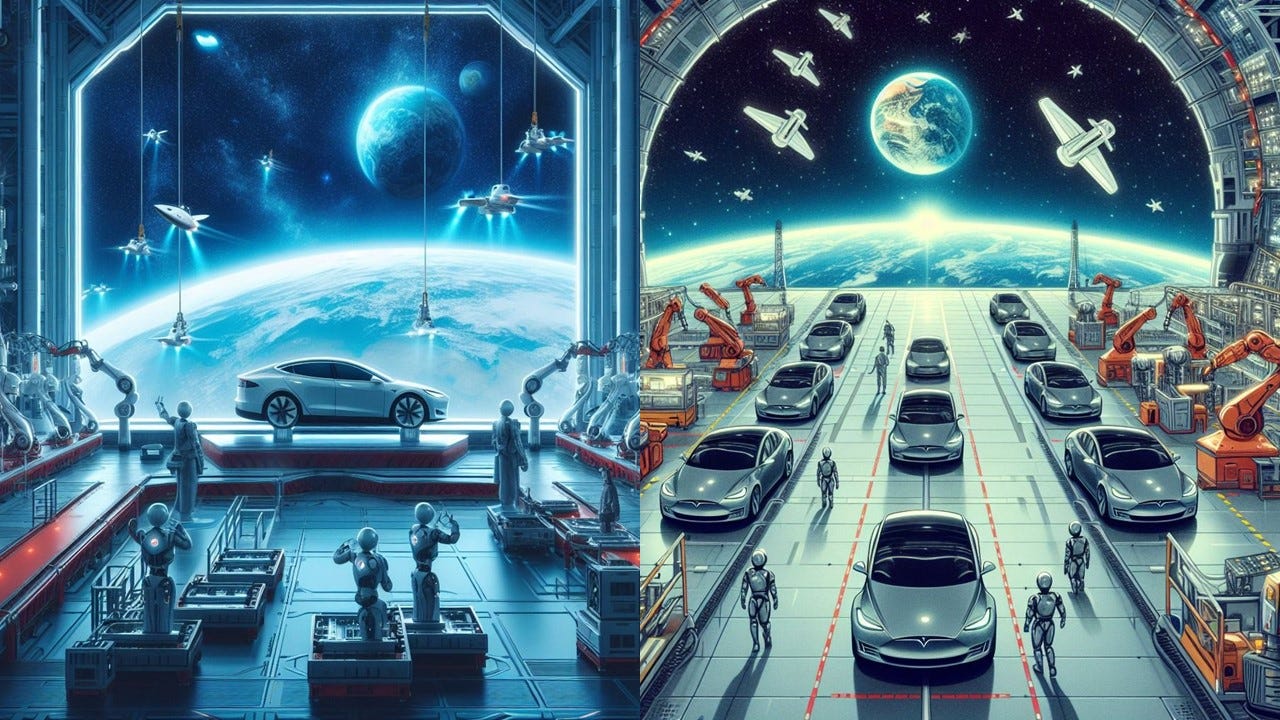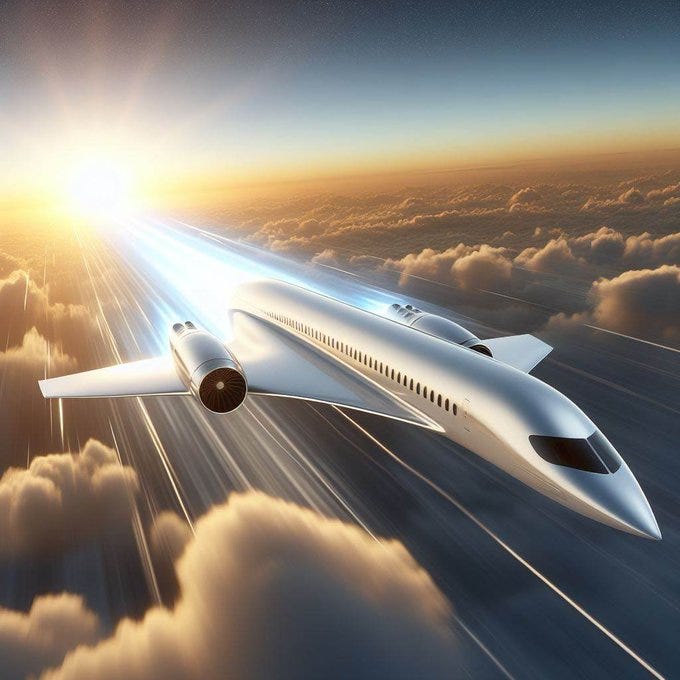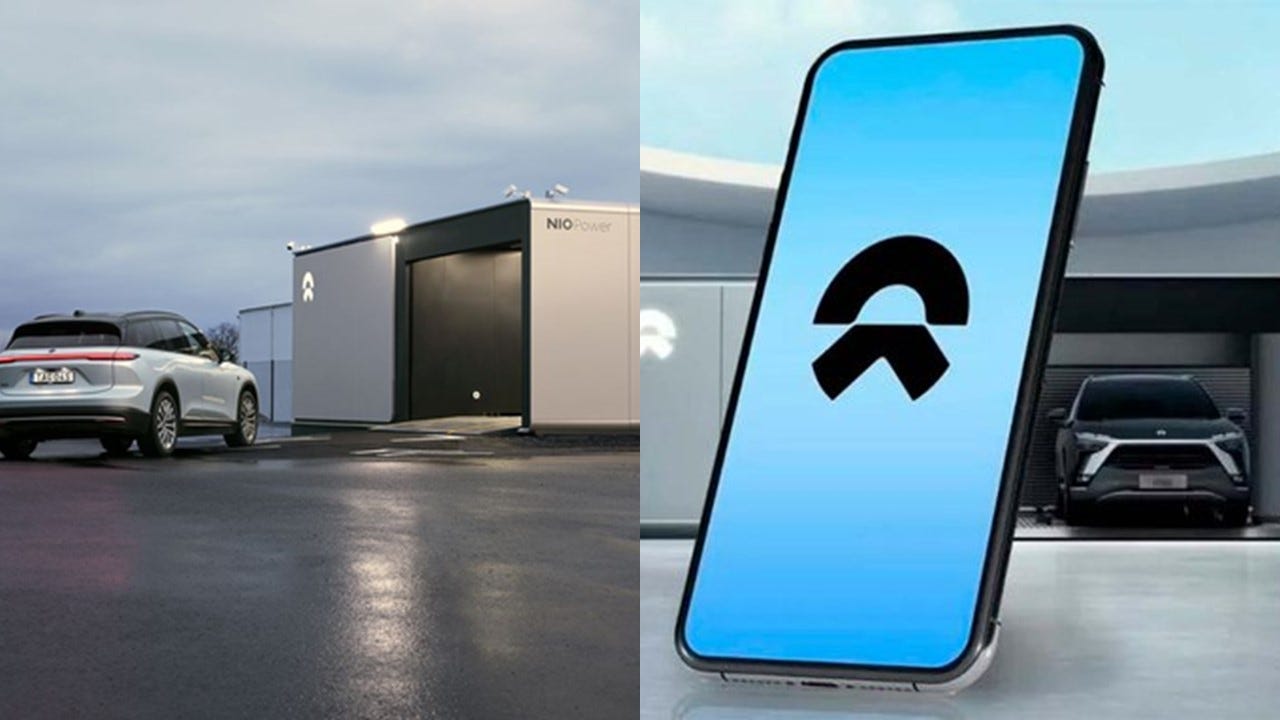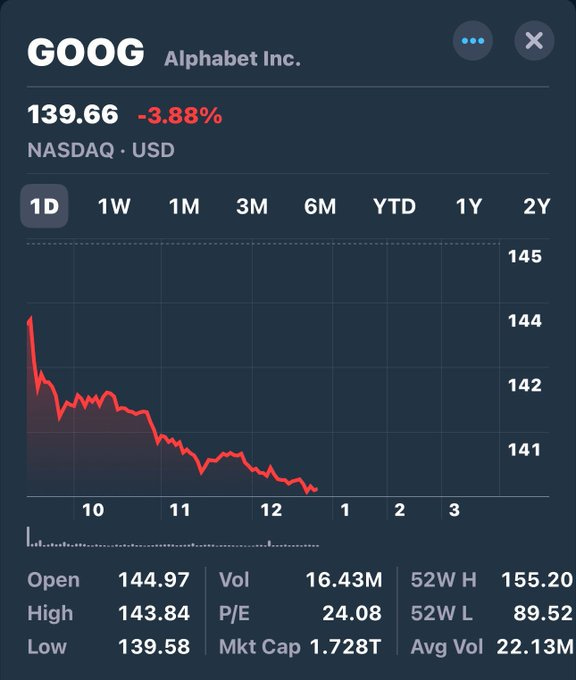#2 - R&V Journal
It's not the Model 2 + Peter Thiel is wrong about Europe + The First Space-Based Factory + The Second Jet Age + Hardware Cold War 2.0 + Tesla's Energy Empire + NIO's Game-Changing Technology & more...
I'm sorry, guys, it's not the Model 2. You haven't thought it through enough.
In recent days, news has emerged that apparently the future Model 2 has been sighted. The sighting was made by a YouTuber who records drone footage of the Gigafactory in Berlin. It seems that while editing the video, he noticed the supposed new Model 2. I'm not going to argue whether it resembles a Model Y from the photo or if it is indeed the new Model 2.
I don't know that, but I will try to deduce, not through the images, but especially from the comments made during the latest conference call and others by Elon Musk and the Tesla team, that it is NOT the Model 2. Here are the reasons:
Among all the Gigafactories that Tesla has worldwide for car manufacturing: Fremont, Shanghai, Austin, and Berlin, the one in Berlin has the least possibility of producing the new Model 2. It doesn't make sense. Berlin should focus on increasing production of the current models it already manufactures. The demand for Tesla cars in Europe cannot be met partly because Gigaberlin does not produce enough.
In the last conference call, Elon detailed quite well what the development process of the Model 2 will be and where the engineering and production process will take place. It will be in Austin; in fact, it will be there where we will see the first Model 2 prototypes, not in Berlin. Once the optimized manufacturing process is achieved in Austin, it will be exported to other Gigafactories. It is most likely that production will first be attempted in Shanghai, which is much better at manufacturing than Berlin, and then in Nuevo León, Mexico. Until the production process of the Model 2 in Austin is polished, the construction of GigaMexico will not begin because they still do not know what the factory should be like to meet Tesla's standards. If Giga Mexico is ever built.
Therefore, all these rumors and claims by some official media that it is the new Model 2 demonstrate that journalists DO NOT READ what the brand itself says and accept as truths what clearly, with a little deduction and logic, is obviously false.
I understand the desire of the community and investors for the long-awaited Model 2 to finally appear, but unfortunately, that "car" seen in Berlin is not the Tesla Model 2.
Peter Thiel is wrong about Europe
I am European, Spanish to be accurate. I've heard the claim quite often that Europe is in decline, that it won't be able to compete with the most innovative players in the world such as the USA, China, and others.
People tend to forget that Europe is more than just France, Italy, Spain, and Germany.
While these nations are indeed significant, there are other countries in Europe that are true leaders in shaping the future of humanity and prospering in the process.
In Europe, you have countries like Switzerland, Luxembourg, the Netherlands, the Baltic states, and the Nordic countries. All of them are at the forefront in various fields.
For instance, Switzerland is a true magnet for talent from around the world. It boasts cutting-edge technology, scientific advancements, and a pharmaceutical industry that ranks among the best globally.
This competitive advantage is poised to grow even further in the future, as more and more talented individuals seek better opportunities outside their home countries, opting for places like Switzerland or other European nations.
The First Space-Based Factory
In the grand odyssey of humanity's ascent towards the cosmos, Tesla envisions a paradigm-shattering leap: the establishment of the first-ever space-based GigaFactory, a cosmic sanctuary of innovation and boundless potential. Breaking free from the terrestrial constraints of bureaucratic entanglements and governmental regulations, this celestial endeavor represents the epitome of liberation and autonomy.
In the weightless expanse of space, untethered from the gravitational shackles of Earth, Tesla's GigaSpace emerges as a beacon of unfettered creativity and unrestricted ingenuity. Here, amidst the vastness of the cosmic canvas, the company's visionary aspirations know no bounds, as it pioneers a new frontier of industrial prowess beyond the reach of earthly politics.
Liberated from the stifling grip of governmental oversight, the space-based GigaFactory becomes a bastion of freedom, where the laws of innovation reign supreme and the spirit of exploration knows no limits. Unencumbered by terrestrial regulations, Tesla's cosmic venture propels humanity into a future where creativity knows no bounds and the bounds of possibility are continually pushed beyond the stars.
In this celestial realm of untamed potential, the value of Tesla transcends earthly limitations, soaring to unprecedented heights as it charts a course towards the infinite horizon of cosmic prosperity. As the cosmic tapestry unfolds, Tesla's GigaSpace stands as a testament to the indomitable spirit of human endeavor, where the pursuit of progress knows no boundaries and the freedom to explore the cosmos is embraced with open arms.
The Second Jet Age
While studying supersonic/hypersonic aerospace flights, I've come to realize that many technological breakthroughs occurred in the 1960s. These breakthroughs primarily revolved around two major fields:
1) engine power and
2) materials capable of withstanding the high temperatures associated with such speeds.
Aerodynamics also play a significant role, whether by reducing the amount of thrust required or by lowering the temperature of the aircraft's structures, including the airframe, surface controls, and engine.
In my opinion, the crux of the issue lies in material science. Advancements in this field could significantly drive innovation by developing new materials, aided by AI tools. With AI, we can explore a multitude of material combinations tailored to meet the challenges posed by hypersonic flights.
Hardware Cold War 2.0 Risks
Verily, I find kinship with her thoughts, yet a shadow of concern looms amidst her words, hinting at the peril of insular ways. Indeed, our labors ought to span the bounds of nations, for the rekindling of greatness is a task beyond mere borders.
But within this hopeful tapestry, the specter of a Cold War 2.0 emerges, a dire conflict fraught with peril, yet holding the potential for great societal transformation. Such is the intricate dance of ideals and ambitions that shapes our shared fate.
Tesla's Energy Empire
It is common to think of Tesla solely as a car company, merely engaged in the business of selling automobiles. However, when we widen the focus, it becomes apparent that Tesla is a multifaceted entity. While it is indeed a technology company, specifically in robotics and AI, it is more than that.
Tesla embodies a conglomerate of enterprises within itself. This phenomenon is mirrored within the current "Big 7" - FAANG or the Chinese BAT (Baidu, Alibaba, and Tencent). In China's case, numerous others such as JD, Pinduoduo, ByteDance (TikTok), BYD, and others, though lesser-known in the West, will likely gain recognition in the future. I anticipate that China won't settle for just 7, given its size, nearly four times that of the USA, and the exponential growth it's experiencing. China may see the emergence of "Big 16," "Big 24," or even "Big 32," always in multiples of 8, considered auspicious in Chinese culture. This last assertion is speculative but allows for a broader perspective.
With the above, I want to emphasize the nature of these companies. Most are not just companies; they are creators of companies. While they remain part of the same matrix, their entrepreneurial spirit, embedded within the corporate culture, coupled with excellent leadership, drives constant reinvention and the development of new business models. They leverage emerging technologies, either self-developed or refined, to create value for society at large.
Returning to the initial argument, there's a tendency to pigeonhole Tesla as solely a car manufacturer, yet it is also a significant player in battery manufacturing within the Energy Storage industry. This division within Tesla is aptly named Energy Storage. It's a vertical sector experiencing exponential growth, with Tesla executives, including Elon Musk, suggesting that the energy business will eventually surpass that of automobiles in the long run.
Undoubtedly, the growth in the energy storage segment far outpaces that of Electric Vehicles (EVs). In just a year, deliveries (factories + sales) have surged from 6.5 GWh in 2022 to approximately 15 GWh in 2023, signifying substantial growth. Elon Musk himself has stated that the energy sector will grow much faster than the automotive division and may eventually surpass it.
The energy storage industry is incredibly fascinating, as it's a sector that didn't exist previously and is poised to encompass a broader array of markets in the future, many of which are yet unforeseen. Some potential applications include cryptocurrency mining, utility business, data centers, computing, among others, which could generate significant synergies with existing industries.
The Power of Swap: NIO's Game-Changing Technology
Among all Chinese EV brands, NIO stands out as one of the most intriguing. While competitors within the Chinese market, such as Xiaomi, Huawei, and others, aim to construct ecosystems around all electronic devices, including cars, NIO takes a unique approach.
Unlike Xiaomi and Huawei, which started with smartphones, NIO initially focused on electric vehicles before branching out to other devices. They have even launched the NIO phone. However, what truly sets NIO apart, in my view, is its battery swap technology.
While they already offer super-fast charging, the battery swap technology represents a clever alternative. What's particularly fascinating is the infrastructure of the swap stations, which could potentially rival Tesla's Energy Storage concept.
These swap stations boast significant computing power, including AI compute with NVIDIA chips, and NIO is also developing its own chips.
It's not hard to envision these stations serving as energy supply hubs, housing numerous batteries, training AI models, engaging in cryptocurrency mining, and becoming integral to the future finance blockchain industry, as well as other industrial applications such as electric utility companies.
While some may question the viability of this concept, swap stations hold immense potential and, akin to Tesla, could ultimately surpass the value of the automotive segment of the company.
Google-Proof: Market Superior to Government Regulation
All the fuss stirred up about Google's ideological use of its AI demonstrates that the market and the people are better regulators than the authorities.
There's an existential fear looming over the possibility that big corporations might not only dominate but also wreak havoc.
Well, that moment has arrived, and it seems Google (Alphabet) is paying the price for manipulating and misusing AI, something that people vehemently reject.
Depending on how they address the issue, this could be a turning point for the company.
They can follow in the footsteps of Microsoft or Twitter, making the company much better and truly more innovative for the future.
Alphabet has tremendous potential, but they must abandon wokeism and better understand the market and customers.
Depending on that, it could either become a 10-bagger from these prices or plummet to zero like Kodak, Blackberry, and other business failures.
NIO x Dune2 . Next market: AR/VR. William Li's army is coming.
NIO's collaboration with #Dune2 is just the beginning of its foray into the AR/VR market. With competitors like Meta and Apple in its sights, NIO, led by CEO William Li and his formidable team of engineers, is poised to make a significant impact. Get ready—the revolution is coming.







